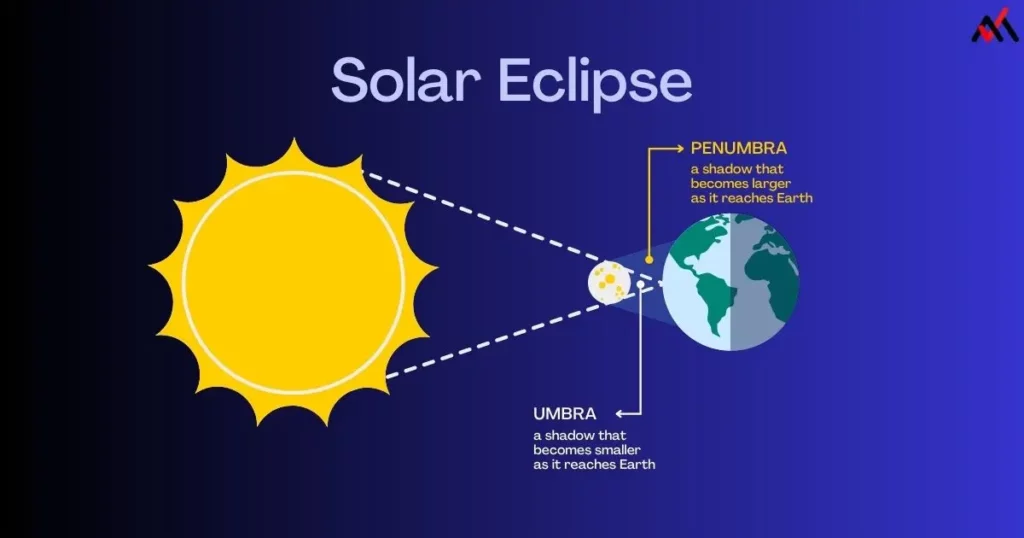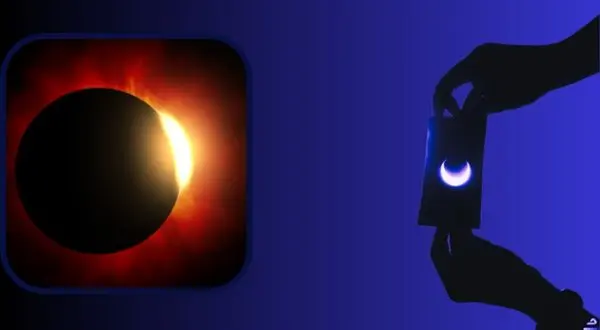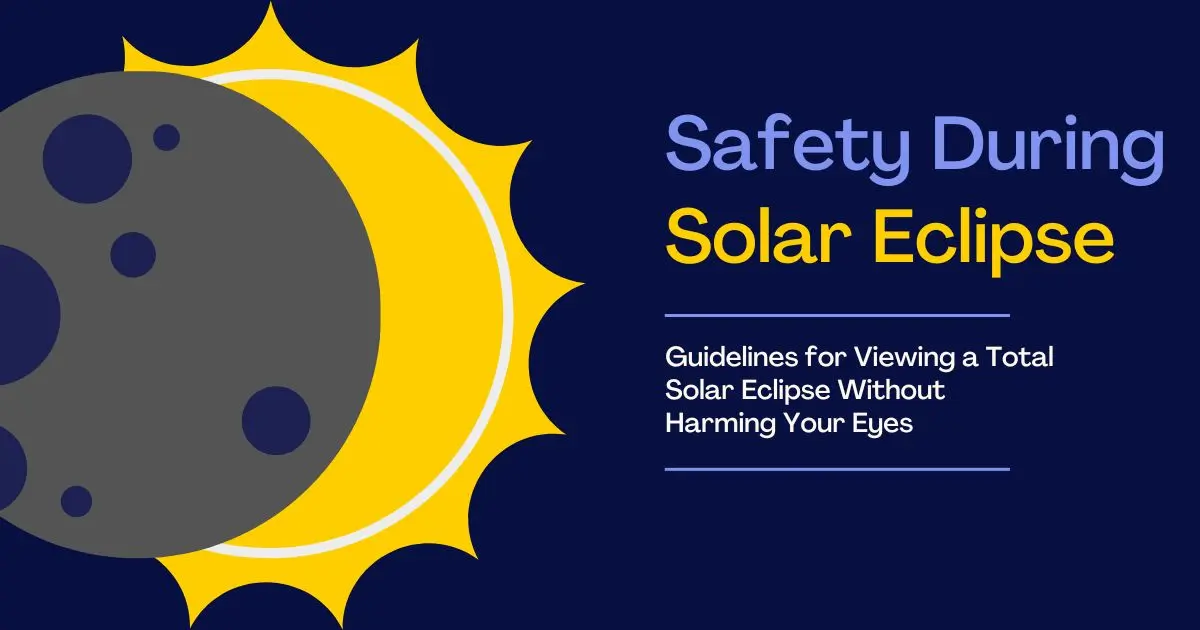The awe-inspiring phenomenon of a total solar eclipse is a rare and captivating event that draws people from all over the world to witness the majestic dance between the moon and the sun.
However, it’s important to remember that the sun’s powerful rays can be incredibly harmful to our eyes, and precautions must be taken to ensure the safety of our vision during this natural wonder.
Page Index
- Protecting Your Eyes: A Non-Negotiable Priority
- Different Types of Solar Eclipses and Ensuring Safe Viewing
- Eclipse Glasses
- How Do I View an Eclipse Safely?
- Navigating the Phases of Totality
- Preparation and Vigilance
- Science and Wonder of Total Solar Eclipses
- Indirect Observation
- Photography and Technology
- International Exploration and Cultural Significance
- Final Thoughts
- Author
Protecting Your Eyes: A Non-Negotiable Priority
It’s a widely known fact that looking directly at the sun, even when it’s partially obscured, can cause serious and irreversible damage to your eyes. This is a crucial point to emphasize: under no circumstances should you attempt to observe a solar eclipse without proper eye protection. Whether it’s a partial eclipse or the glorious moment of totality, your eyes require safeguarding.
Different Types of Solar Eclipses and Ensuring Safe Viewing
Imagine the sky putting on a show where the sun, moon, and Earth all play their parts. These are solar eclipses – incredible events that make us look up in wonder. But as we enjoy the celestial spectacle, it’s super important to keep our eyes safe. Let’s explore the different types of solar eclipses and how to watch them without harming our eyes.
Partial Solar Eclipse
In this type, the moon covers part of the sun, making it look like the sun is wearing a moon hat. Some lucky folks might see a total solar eclipse, but most will catch a partial one. No matter which one you’re watching, never look directly at the sun during this time – it’s just not safe.
Total Solar Eclipse
Picture the moon fully covering the sun, turning daytime into night for a little while. This is a total solar eclipse. Some places will see this amazing sight, while others will only have a partial view.
Here’s a cool thing: during the total eclipse, you can take off special glasses (not regular sunglasses) and look at the sun. But remember, this is only safe for a short time, about 2-4 minutes. After that, back to protecting your eyes.
Annular Solar Eclipse
In this show, the moon doesn’t cover the sun completely, making the sun look like a shiny ring – like the “Ring of Fire.” This happens during the maximum point of the eclipse. And, just like before, you should never look directly at the sun during this time, unless you have special filters.
Eclipse Glasses
Eclipse glasses are your trusty companions when it comes to watching any phase of a solar eclipse. During a partial eclipse, when the sun is only partially covered by the moon, eclipse glasses should be worn at all times if you wish to gaze at the sun.
These specially designed glasses have a unique filter that blocks out the harmful ultraviolet (UV) and infrared (IR) rays emitted by the sun, allowing you to observe the eclipse safely.
Even during the magical phase of totality, when the moon fully obscures the sun, eclipse glasses play a crucial role. The key is to know precisely when you can safely remove them and when they must be worn again.
How Do I View an Eclipse Safely?
The allure of a solar eclipse is undeniable – the sun and moon in a cosmic dance, creating a breathtaking spectacle that captivates observers around the world.
However, enjoying this celestial performance comes with a crucial caveat: the safety of your eyes must always take precedence. Let’s delve into the vital practices of observing an eclipse without compromising your precious vision.
Solar Filters
Imagine, if you will, a pair of enchanted glasses that allow you to witness the sun’s majesty without harm. These magical artifacts, known as solar filters, take the form of specialized gear such as eclipse glasses or handheld solar viewers.
Their purpose is clear – to let you behold the sun’s splendor while guarding your eyes against its formidable radiance.
The Window of Safe Gazing
A cardinal rule to remember is that gazing at the sun without a solar filter is only permissible during the fleeting 2-4 minutes of totality when the moon has completely obscured the sun.
It is during this brief interval that you can safely marvel at the solar corona and its ethereal beauty. However, and I must emphasize this, never dare to cast your eyes upon the sun without proper protection during any other phases of the eclipse – whether it’s a partial or annular eclipse.
Selecting Solar Filters
When selecting solar filters, look for those bearing the ISO 12312-2:2015 certification, a mark of their authenticity and safety. These filters should also display the manufacturer’s name and address – hallmarks of genuine products.
Please note, filters that lack ISO certification information, appear torn or scratched, have wrinkled lenses, show signs of detachment from their frames, or were produced before 2015 should be discarded, for your eyes’ sake.
Guidelines for Proper Usage
To unlock the solar spectacle safely, adhere to these guidelines:
- Inspect Your Solar Filter: Before use, scrutinize your solar filter. If it’s scratched, damaged, or compromised in any way, do not take chances – replace it immediately. Safety is paramount.
- Adorn Your Eclipse Glasses: If you’re wearing eclipse glasses or using a handheld solar viewer, put them on before directing your gaze towards the sun. Your eyes deserve this protective veil.
- Step Back from the Sun: After relishing the sun’s sight through your solar filter, always turn away from the sun before removing the filter. Remember, do not attempt to remove the filter while looking at the sun directly.
- Totality Unveiled: For those fortunate enough to stand within the path of totality, the grand reveal arrives when the moon fully conceals the sun’s face, enveloping everything in otherworldly darkness. Only then can you cautiously remove your solar filter to savor the celestial scene.
As we delve into the mysteries of the cosmos, let us remember to respect the powerful brilliance of the sun. With the right knowledge and protective measures, you can partake in the enchantment of an eclipse without endangering the very eyes that allow you to explore the universe’s wonders.
- The Diamond Ring Effect: As the moon begins to move in front of the sun, there comes a breathtaking moment when only a single, brilliant spot remains visible – a phenomenon known as the diamond ring effect. While this may be a mesmerizing sight, it’s not yet time to remove your eclipse glasses. The sun’s atmosphere still surrounds the moon, and looking directly at this stage can be damaging to your eyes.
- Baily’s Beads: The diamond ring gives way to another captivating display – Baily’s Beads. These are points of light that shine around the moon’s edges, caused by sunlight streaming through valleys along the moon’s horizon. However, resist the temptation to gaze without protection, as these beams of light can still pose a risk to your eyes.
- Safe to Look: Only when Baily’s Beads disappear and all direct sunlight ceases should you consider looking at the total eclipse without your eclipse glasses. This magical phase, where the moon covers the sun entirely, allows you to witness the solar corona – the sun’s outer atmosphere – in all its glory.
- Timing Matters: Keep in mind that the period of totality can be brief, lasting only a minute or two in some locations. As the moon starts to move away from the sun, watch for the lower atmosphere of the sun to begin peeking out from behind the moon on the opposite side from where the diamond ring first appeared. This signals the end of totality and a reminder to protect your eyes once again.
- Repeating the Process: Just as the beginning of the eclipse brought the diamond ring and Baily’s Beads, the end stages of the eclipse mirror this sequence. Baily’s Beads reappear, followed by the diamond ring, until the sun is fully visible once more. Throughout these final stages, maintain your eye protection to ensure your eyes stay safe.
Preparation and Vigilance
Before setting out to witness a total solar eclipse, arm yourself with knowledge about the local eclipse timings. Websites like ISRO, and NASA’s Eclipse Times page can provide accurate information.
It’s also beneficial to be aware of the visual cues provided by the sun itself as totality approaches and ends. This proactive approach will help you make informed decisions about when to use your eclipse glasses and when it’s safe to admire the eclipse with the naked eye.
Science and Wonder of Total Solar Eclipses

As we delve deeper into the science behind total solar eclipses, it becomes evident that these events are not just breathtaking visual displays, but also valuable opportunities to learn about our universe. During totality, when the moon completely covers the sun, the solar corona – the sun’s outer atmosphere – becomes visible.
This shimmering halo of light provides scientists with insights into the sun’s magnetic fields, solar wind, and other phenomena that are otherwise difficult to study. By ensuring our eye safety during totality, we can fully appreciate and contribute to the scientific understanding of these cosmic occurrences.
Indirect Observation

While the allure of gazing directly at a total solar eclipse is undeniable, there are alternative methods of observation that can be equally captivating and completely safe for our eyes. One such method is the use of a pinhole projector or a simple projection setup.
By allowing the sun’s image to project onto a surface, such as a piece of paper or a screen, you can watch the eclipse unfold without risking any damage to your eyes. This approach can be particularly engaging for group gatherings, as it provides a shared experience while prioritizing eye safety.
Regardless of the type of solar eclipse, the overarching principle remains the same: safeguard your eyes. The sun’s powerful rays can cause irreversible damage to your vision if you view the eclipse without proper protection. Regular sunglasses are not sufficient; you must use designated eclipse glasses or other approved viewing methods.
Whether you’re witnessing a partial eclipse, the awe-inspiring totality, or the dazzling “Ring of Fire,” the golden rule is to always keep your eyes shielded when gazing at the sun. As you immerse yourself in the wonders of the universe, ensure that you prioritize your eye safety above all else.
Photography and Technology
Advancements in technology have opened up new avenues for experiencing and documenting total solar eclipses. With the use of specialized solar filters, photographers can capture stunning images of the eclipse’s various phases, showcasing the intricate details of the solar corona and the moon’s shadow.
These images not only contribute to our visual appreciation of these events but also provide valuable data for scientific research.
International Exploration and Cultural Significance
Total solar eclipses are truly global events that transcend borders and cultures. People from different corners of the world travel to witness these celestial occurrences, creating a shared experience that transcends language barriers.
Additionally, throughout history, various cultures have attached unique significance and interpretations to solar eclipses, often weaving them into their myths, legends, and religious beliefs. This cultural richness adds depth to the universal awe inspired by these cosmic events.
Final Thoughts
As we prepare for the next total solar eclipse, let us approach the event with a sense of wonder, respect, and responsibility. By prioritizing eye safety, staying informed about eclipse timings, and exploring alternative methods of observation, we can fully immerse ourselves in the magnificence of the universe without compromising the well-being of our vision.
Total solar eclipses are not just celestial spectacles; they are reminders of the beauty and complexity of our world and our place within it. So, whether you’re a seasoned astronomer or someone experiencing the magic for the first time, remember to keep your eyes protected and your heart open to the extraordinary.
In conclusion, the allure of a total solar eclipse is undeniably powerful, but it should never compromise your eye safety. Remember that your eyes are precious, and irreversible damage can occur if proper precautions are not taken.
By using eclipse glasses, understanding the phases of totality, and being vigilant about protecting your vision, you can fully enjoy the celestial spectacle while keeping your eyes out of harm’s way.


